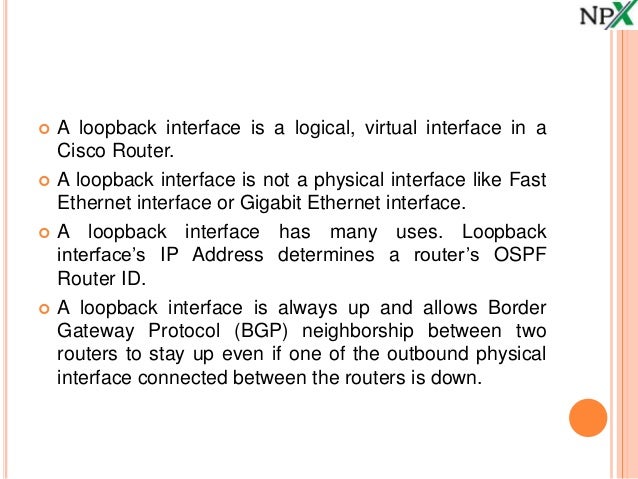Loopback Interface
This article describes how to install the Microsoft Loopback Adapter.
Show interface loopback lo-number brief description Syntax Description. Loopback interface number. The range is from 0 to 1023. Brief (Optional) Displays a brief summary of the loopback interface information. Description (Optional) Displays the description provided for the loopback interface. Command Default. When you install a loopback adapter, the loopback adapter assigns a local IP address for your computer. After the loopback adapter is installed, there are at least two network adapters on your computer: your own network adapter and the loopback adapter. Create a loopback interface with PowerShell. Some load balancers may require you to create a loopback interface on a Windows server or servers. The loopback device then gets the load balanced IP added to it; that IP is used for the inbound load balanced connections. A loopback interface has the following features: Is always Up and has the loopback feature. Can be configured with the mask of all 1s. Based on the preceding features, the loopback interface has the following applications. The IP address of a loopback interface is specified as the source address of packets to improve network reliability. Configure the loopback interface. Oddly, the device’s loopback address is not used to loop traffic back to the sender. However, it is a stable address for the device that can be used whether or not a particular physical interface is down. Once each network interface has an address, it can send and receive traffic.
Original product version: Windows Server 2003
Original KB number: 842561
Purpose Of Loopback Interface
Introduction
This article describes how to install the Microsoft Loopback Adapter in Microsoft Windows Server 2003. You can install the adapter by using a command prompt or by using the Hardware Wizard.
Loopback Interface Ospf
More information
Method 1
To quickly install the Microsoft Loopback Adapter in Microsoft Windows Server 2003, use the DevCon utility at a command prompt. To download and to run the DevCon utility, follow these steps:
Download the DevCon compressed file, and then extract the files:
Visit the following Microsoft Web site:
https://download.microsoft.com/download/1/1/f/11f7dd10-272d-4cd2-896f-9ce67f3e0240/devcon.exeSave the Devcon.exe file to a folder on your computer, and then open the folder.
Double-click Devcon.exe. A WinZip Self-Extractor dialog box appears.
In the Unzip to path box, type the folder where you want to unzip the files, and then click Unzip.
Click OK, and then Close to complete the unzip process.
Install the Microsoft Loopback Adapter:
At a command prompt, change directory to the folder where you extracted the DevCon files.
Change directory to the i386 folder.
Type devcon.exe install %windir%infnetloop.inf *msloop, and then press ENTER. You see output that is similar as:
Device node created. Install is complete when drivers are updated...
Updating drivers for *msloop from C:WINDOWSinfnetloop.inf.
Drivers updated successfully.Close the command prompt.
Click Start, click Control Panel, and then click Network Connections to verify that the Microsoft Loopback Adapter has been installed.
Method 2
Loopback Interface Speed
To install the Microsoft Loopback Adapter by using the Hardware Wizard, follow these steps:
In Control Panel, double-click Add Hardware, and then clickNext
Click Yes, I have already connected the hardware, and then clickNext.
At the bottom of the Installed hardware list, click Add a new hardware device, and then click Next.
Click Install the hardware that I manually select from a list, and then click Next
In the Common hardware types list, click Network adapters, and then click Next.
In the Manufacturers list box, click Microsoft.
In the Network Adapter list box, click Microsoft Loopback Adapter, and then click Next.
Click Next to start installing the drivers for your hardware.
Click Finish.
Click Start, click Settings, and then click Network Connections to verify that the Microsoft Loopback Adapter has been installed.

References
For additional information about the DevCon utility, click the following article number to view the article in the Microsoft Knowledge Base:
311272 DevCon command-line utility alternative to Device Manager